WRITE A LINEAR INEQUALITY OF TWO VARAIBLES FROM A GRAPH
Subscribe to our ▶️ YouTube channel 🔴 for the latest videos, updates, and tips.
To write a linear inequality in two variables, we have to understand the shaded region given. First let us see the inequality signs that we use.
|
< > ≤ ≥ |
Less than Greater than Less than or equal to Greater than or equal to |
In general after drawing the line, to fix the solution region
- Take one of the point above the line and check if the point satisfies the inequality. If it is so, we can fix the region above the line is the solution region.
If it doesn't work
- Take one of the point below the line and check if the point satisfies the inequality. If it is so, we can fix the region below the line is the solution region.
Problem 1 :
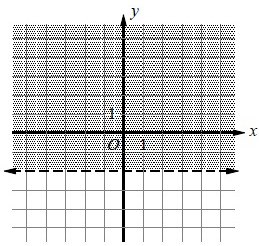
Which of the
following inequalities represents the graph above?
a. x > -2 b. x < -2 c. y > -2 d. y < -2
Solution :
By observing the graph, the dotted line passes through y = -2. Comparing with other values on y-axis, -1, 0, 1,...... are greater than -2.
So,
y > -2
Problem 2 :
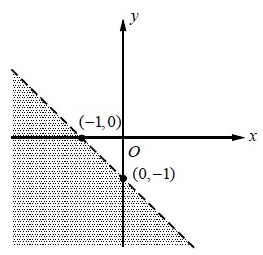
Which of the
following inequalities represents the graph above?
a. x + y < -1 b. x + y > -1
c. x + y ≤ - 1 d. x + y ≥ -1
Solution :
Rise = -1 and Run = 1
Slope = -1/1 = -1
y- Intercept = -1
So, the equation of the given line is
y = -x - 1
Take the point (-2, -2) and apply it in the equation
y = -x - 1
-2 = 2 - 1
-2 = 1
Here -2 is less than 1, so we have to choose the < instead of equal sign in the equation y = -x - 1.
y < - x - 1
x + y < -1
Hence, the required inequality is
x + y < -1
Problem 3 :
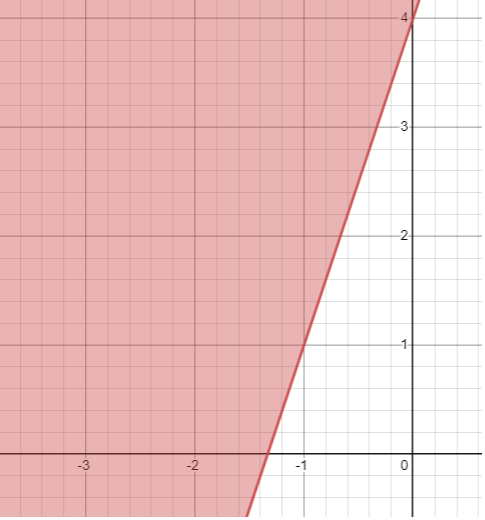
Solution :
y- Intercept = 4
Slope :
Rise = down 3 units ==> -3
Run = left 1 unit ==> -1
Slope = -3/(-1) ==> 3
So, the equation of the given line is
y = 3x + 4
Taking one of the point from the shaded region and applying in the equation, we get
(-2, 1)
1 = 3(-2) + 4
1 = -6 + 4
1 = -2
Here -2 is less than 1, so we have to choose the > instead of equal sign in the equation y > 3x + 4
In the given graph, since it is solid line, we have to use ≥ sign.
Hence, the
required inequality is
y ≥ 3x + 4
Problem 4 :
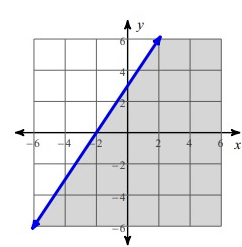
Solution :
Rise = 3 and Run = 2
Slope = 3/2
y- Intercept = 3
So, the equation of the given line is
y = 3/2x + 3
Take the point (2, 2) and apply it in the equation
y = 3/2x + 3
2 = 3/2(2) + 3
2 = 3 + 3
2 = 6
Here 2 is less than 6, so we have to choose the < instead of equal sign in the equation y = 3/2x + 3.
Hence, the required inequality is
y < (3/2)x + 3
Problem 5 :
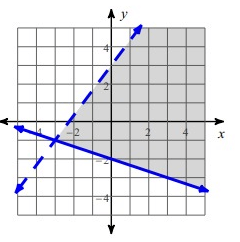
Solution :
Rise = 4 and Run = 3
Slope = 4/3
y- Intercept = 3
So, the equation of the given line is
y = 4/3x + 3
Take the point (3, 3) and apply it in the equation
y = 4/3x + 3
3 = 4/3(3) + 3
3 = 4 + 3
3 = 7
Here 3 is less than 7, so we have to choose the < instead of equal sign in the equation y = 4/3x + 3.
y < 4/3x + 3
Rise = -2 and Run = 6
Slope = -2/6 = -1/3
y- Intercept = -2
So, the equation of the given line is
y = -(1/3)x - 2
Take the point (3, 1) and apply it in the equation
y = -(1/3)x - 2
1 = -(1/3)(3) - 2
1 = -1 - 2
1 = -3
Here 1 is greater than -3, so we have to choose the ≥ instead of equal sign in the equation y = -1/3x - 2.
y ≥ -1/3x - 2
Hence, the required inequality is
y < 4/3x + 3
y ≥ -1/3x - 2
Problem 6 :
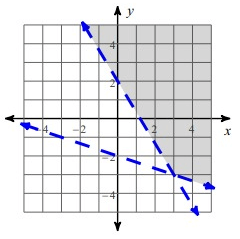
Solution :
Rise = -2 and Run = 1
Slope = -2/1 = -2
y- Intercept = 2
So, the equation of the given line is
y = -2x + 2
Take the point (3, 2) and apply it in the equation
y = -2x + 2
2 = -2(3) + 2
2 = -6 + 2
2 = -4
Here 2 is greater than -4, so we have to choose the > instead of equal sign in the equation y = -2x + 2.
y > -2x + 2
Rise = -2 and Run = 5
Slope = -2/5
y- Intercept = -2
So, the equation of the given line is
y = -2/5x - 2
Hence, the required inequalities are
y > -2x + 2
y = -(2/5)x - 2
Subscribe to our ▶️ YouTube channel 🔴 for the latest videos, updates, and tips.
Recent Articles
-
Finding Range of Values Inequality Problems
May 21, 24 08:51 PM
Finding Range of Values Inequality Problems -
Solving Two Step Inequality Word Problems
May 21, 24 08:51 AM
Solving Two Step Inequality Word Problems -
Exponential Function Context and Data Modeling
May 20, 24 10:45 PM
Exponential Function Context and Data Modeling